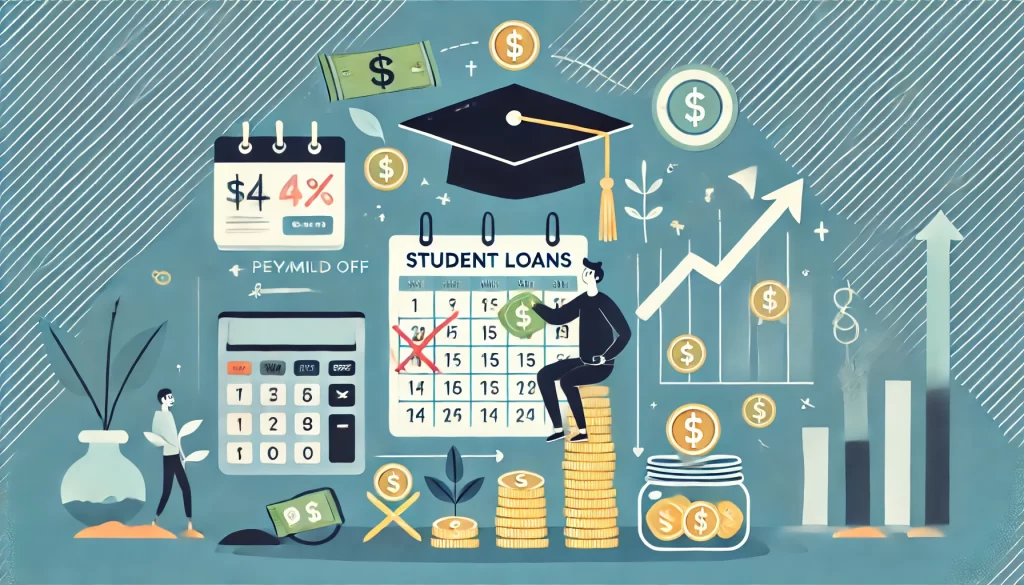Imagine standing at the start of a new chapter, diploma in hand and dreams big. But, as you celebrate, a less joyful mail arrives – your student loan bill. Managing student loans starts like our adult lives: with hope and a dose of reality. It shows us that financial freedom needs a solid plan.
To tackle student loans, you need smart repayment tactics that fit your budget. As we enter 2024, getting ready for loan payments is key. Make sure your contact info is up to date with your loan servicers and StudentAid.gov. This keeps you informed about due dates, payment amounts, and interest.
The bill will tell you when to pay, giving you 21 days to get ready. But, setting up auto pay can lower your interest rate by 0.25%. This small win helps in the fight against debt.
Life can be unpredictable. If you can’t pay on time, don’t worry. Until September 30, 2024, you have a grace period. But, don’t delay, as missing payments can hurt your credit score and lead to default.
For those struggling, Income-Driven Repayment (IDR) plans offer hope. They can make payments as low as $0, based on your income. Public servants can also look forward to loan forgiveness after 120 qualifying payments.
Whatever your situation, the Loan Simulator can help you understand your options. As we start repayment in 2024, let’s be careful and manage our finances well. This way, we can graduate not just educated but also debt-free.
Updating Contact Information: The First Step in Student Loan Management
Starting to manage your student loans means one key step: updating your contact information everywhere it matters. With student loan payment options from servicers like Edfinancial and MOHELA, you get vital updates. This is especially true when repayment starts.
Having the right info helps you avoid missing important messages about payments and loan changes. This is key for how to pay off student loans well. With the class of 2019 nearing repayment time, it’s more important than ever.
Also, checking your student loan dashboard on StudentAid.gov lets you confirm your servicer’s info. This makes sure you’re ready for your financial duties ahead.
Private student loans need updated contact info too, found on AnnualCreditReport.com. This keeps you in the loop about your loans and repayment plans. Whether you choose standard or income-driven plans, keeping your info current helps you move smoothly through your financial journey.
By keeping your contact info current, you lay a strong base for managing your loans. This simple step is crucial for finding the best student loan payment options. It’s a big step towards becoming debt-free, showing the importance of smart loan repayment strategies.
Understanding Repayment Plans: Discover Your Best Options
Managing student loans can seem overwhelming. But, with the right info, you can find ways to pay off your debt. This could save you thousands over time.
Income-Driven Repayment Plans: A Custom Approach to Your Payments
Income-Driven Repayment (IDR) plans are made for you. They adjust payments based on your income and family size. You might even pay $0 a month.
These plans also offer forgiveness after 20 to 25 years. This is a big plus for long-term borrowers.
The SAVE Plan: Analyzing the Latest Income-Driven Repayment Option
The SAVE Plan is a new IDR option. It aims to lessen the weight of student debt. It offers terms like cutting payments by half for some borrowers.
If you want to reduce your debt, look into the SAVE Plan. It might be a good choice for you.
Loan Simulator: A Tool for Navigating Repayment Choices
The Loan Simulator is a helpful tool. It lets you see how different repayment plans work. This way, you can choose the best plan for you.
In conclusion, knowing your repayment options is key. Whether you’re starting or looking for better plans, it’s important. Tools like Loan Simulators and plans like SAVE can help you manage your loans well. This could lead to forgiveness in the future.
How to Pay Off Student Loans: Strategies for Tackling Debt
Starting to pay off student loans can feel overwhelming. But, with the right strategies and knowledge, you can pay off your debt faster. We’ll look at ways to manage and reduce your student loan debt.
Income Adjustment: Recertifying Your IDR Plan for Lower Payments
One key student loan refinancing tip is to recertify your income under an IDR plan. This is great if your income has dropped, letting you pay less each month. Since it takes about 20 years to pay off loans, adjusting your payments can help tackle interest better.
Consolidation: Simplify Payments and Potentially Lower Monthly Costs
Consolidating loans can be smart if you have multiple federal loans. It simplifies payments and might lower your monthly costs. With companies like Earnest and SoFi offering good rates, it could help you pay off loans faster. But, weigh the pros and cons carefully.
Auto Pay Benefits: Saving on Interest and Ensuring Timely Payments
Auto pay makes sure you never miss a payment. Most lenders, like SoFi and Earnest, give a 0.25% interest rate cut for it. This can save a lot over time. Auto pay also helps you tackle interest, making your debt smaller.
By making smart choices about repayment plans, consolidation, and auto pay, you can tackle student loans with confidence. You’ll be on your way to a debt-free life sooner than you think.
Navigating Short-Term Financial Hardships: Deferment and Forbearance
Unexpected financial challenges can disrupt even the best-laid plans, including managing student loan payments. When hardships strike, it’s essential to know your student loan payment options to maintain financial stability. Deferment and forbearance offer temporary relief possibilities, allowing you to pause or reduce your payments under specific conditions.
Deferment is an option aimed at providing breathing room for up to three years. It’s particularly fitting if you’re returning to school, facing unemployment, or experiencing significant life events like military service or serious health conditions. For students with subsidized federal loans, the government might cover the interest during this period, making it an attractive choice for those eligible.
Forbearance, on the other hand, permits a break from loan payments for up to 12 months at a time, with the ability to apply multiple times. This option is crucial for borrowers experiencing temporary inability to meet their payment obligations due to reasons like medical expenses or changes in employment. However, interest continues to accumulate during forbearance, potentially increasing the total amount payable over the life of the loan.
It’s crucial when considering these options to use tools like a Loan Simulator—a tool suggested in smart financial planning articles—to fully understand how deferment or forbearance might affect your future payments and total loan cost. Such proactive managing student loan payments ensures you are not blindsided by accrued interests or elongated payment periods post-hardship.
While deferment and forbearance can provide immediate relief, it’s beneficial to discuss with your loan servicer to understand any long-term implications fully. For example, interest might continue to accrue, or your eligibility for loan forgiveness programs could be affected. Always ensure that the decision to apply for either option aligns with your broader financial goals and capabilities.
Remember, while federal loans frequently come with these relief options, private lenders may not offer them; contacting lenders directly is advisable to explore any available student loan payment options. Making informed decisions during financial hardships can protect your credit score and position you for economic recovery without additional stress.
Consequences of Missed Payments: Delinquency and Default
Missing student loan payments can lead to big financial problems. It can hurt your credit score and make it hard to borrow money in the future. It’s important to find good ways to pay off your student loans to avoid these issues.
When you miss a payment, your loan becomes delinquent. This can really hurt your credit history. Usually, your loan is reported to credit bureaus after 90 days of not paying. So, it’s key to manage your payments well from the start.
Understanding Delinquency and its Impact on Credit
Delinquency starts when you miss a payment. The longer you wait, the worse it gets for your credit score. With an average payment of $393, missing it can cause a lot of stress and harm your credit. It’s important to have good strategies for paying off your student loans to avoid delinquency.
Avoiding Default: How the On-Ramp Period Can Help
A special on-ramp period is available until September 30, 2024. It helps protect you from delinquency and default. This lets you keep your credit score safe while you figure out your finances. It gives you time to adjust without worrying about things like wage garnishment.
This approach is crucial for keeping your finances healthy. It helps avoid the immediate and long-term problems of a defaulted loan. Knowing how to manage your payments is key to staying financially stable while paying off your student loans.
Loan Forgiveness Programs: Opportunities for Reducing Your Debt
Looking into student loan forgiveness programs is a top way to cut down on student loan debt. These programs help ease the financial load of student loans. They offer different options based on your job and life situation.
Public Service Loan Forgiveness (PSLF) is great for those in public service jobs. If you work full-time for the government or a non-profit, you might get your Direct Loans forgiven after 120 payments. This means 10 years of payments under certain plans, helping those in public service a lot.
Public Service Loan Forgiveness: Supporting Those in Public Service Careers
The Teacher Loan Forgiveness program helps teachers in low-income schools. Teachers who work full-time for five years might get up to $17,500 forgiven on their Direct Loans. This helps teachers financially and encourages quality education in poor areas.
Teacher Loan Forgiveness: Rewarding Years of Teaching in High-Need Areas
Health care workers also have special student loan forgiveness options. Programs from the National Health Service Corps, National Institutes of Health, and Indian Health Service can forgive loans. This is for those working in key healthcare roles, often in areas with less access to care. These programs aim to bring skilled health care workers to where they’re most needed.
Understanding Forgiveness for Health Care Providers and Other Specialized Roles
Loan forgiveness and discharge options aren’t just for these jobs. Severe disability, school closures, or educational fraud can also lead to loan discharge. This adds more ways to get financial help.
It’s key to explore student loan forgiveness programs for managing student debt. By understanding and using these options, borrowers can get significant financial relief. This helps in both their professional and personal growth.
Conclusion
Dealing with student loan repayment needs careful planning and strategy. As we move forward, knowing how to tackle how to pay off student loans is key to financial freedom. The 50/30/20 budgeting rule helps create a balanced plan. It suggests setting aside a big chunk for debt repayment, aiming to pay more than the minimum to reduce the principal and save on interest.
Using different student loan repayment strategies can make a big difference. This includes picking the right repayment plan and looking into forgiveness programs. These can cancel up to $20,000 for Pell Grant recipients. Also, smart financial moves like using windfalls and cutting expenses can help pay off debt faster. Plus, student loan refinancing tips like getting lower interest rates can make payments easier and more manageable.
There are many ways to tackle student loan repayment, and you’re not alone. Financial advisors at places like Scott Credit Union offer great advice. They can help you understand your options and make informed choices. With college tuition over $40,000 a year, it’s crucial to know your repayment options. By choosing the right path in 2024, you’ll be on your way to financial health and loan freedom.






